- 6 Hot And In-Demand Tech Areas In 2024
- How To Forward Your Career With Cloud Skills?
- Top 7 On-Demand IT Certifications
- Most In-demand Technologies To Upskill Your Career
- Top 10 Hottest Tech Skills to Master in 2024
- Top Skills You Need to Become a Data Scientist
- Groovy Interview Questions
- Facets Interview Questions
- Crystal Reports Tutorial
- VAPT Interview Questions
- Flutter Tutorial
- Saviynt VS Sailpoint
- Flutter vs Xamarin
- PingFederate Interview Questions and Answers
- Dart vs Javascript : What's the Difference?
- Terraform Private Registry
- Cylance Interview Questions and Answers
- Sophos Interview Questions and Answers
- Top Camunda Interview Questions
- NUnit Interview Questions and Answers
- Impala Interview Questions and Answers
- ETL Tutorial
- Ionic Interview Questions
- Grafana Tutorial
- What is VAPT? - A Complete Beginners Tutorial
- SnapLogic Interview Questions
- Saviynt Interview Questions
- What is PingFederate? - A Complete Beginners Tutorial
- SnapLogic Tutorial
- Grafana Interview Questions
- RHCE Interview Questions and Answers
- Web Services Interview Questions
- Domo Interview Questions and Answers
- Terraform Interview Questions
- What is Sophos? | Sophos Turorial for Beginners
- Top Servlet Interview Question And Answers
- NLP Interview Questions and Answers
- Microsoft Intune Interview Questions
- Top XML Interview Questions And Answers
- Tosca Commander
- Katalon vs Cypress
- SQLite Tutorial
- Tosca Tutorial - A Complete Guide for Beginners
- Xamarin Interview Questions and Answers
- UiPath vs Automation Anywhere - The Key Differences
- OpenShift Interview Questions
- What is Katalon Studio - Complete Tutorial Guide
- Kronos Interview Questions
- Tosca Framework
- Burp Suite Tutorial
- Mendix Interview Questions
- Burp Suite Interview Questions
- What is Mendix
- What is Terraform ?
- Burp Suite Alternatives
- Dart vs Kotlin
- What is Kronos?
- ES6 Interview Questions
- Entity Framework Interview Questions
- COBOL Interview Questions
- Express JS Interview Questions
- OSPF Interview Questions
- LINQ Tutorial
- CSS3 Interview Questions and Answers
- Auth0 Tutorial
- MS Access Interview Questions
- What is SPARQL - A Complete Tutorial Guide
- ExpressJS Tutorial
- UML Tutorial
- HTML vs XML
- Cypress vs Jest
- Impacts of Social Media
- OWASP Interview Questions
- Security Testing Interview Questions
- OpenShift vs Docker
- ES6 Tutorial
- Spark SQL Interview Questions
- Spark SQL Tutorial
- What is OWASP?
- AppDynamics Interview Questions
- Dynatrace Interview Questions
- Rest Assured Tutorial
- New Relic Interview Questions
- REST API Tutorial
- Datadog Interview Questions
- Rest API Interview Questions
- Rest Assured Interview Questions
- PTC Windchill Interview Questions
- Easiest Tech Skills To Learn
- Python SQLite Tutorial - How to Install SQLite
- Datadog Tutorial - Datadog Incident Management
- What is AppDynamics - AppDynamics Architecture
- RabbitMQ Interview Questions And Answers
- What is Dynatrace
- Datadog Vs Splunk
- Web Developer Job Description
- JP Morgan Interview Questions
- Types of Corporate Training
- Benefits of Corporate Training
- What is Corporate Restructuring?
- Blended Learning in Corporate Training
- What is Corporate Level Strategy?
- Flutter Projects and Use Cases
- How to Become a Web Developer
- How To Install Keras?
- How to Install Flutter on Windows?
- How to Install Cypress on Windows?
- How to Become a Computer Scientist?
- How to Install Katalon Studio in Windows
- How to Become a Programmer
- OWASP Projects and Use Cases
- How to Install Sophos?
- Workato Tutorial
- Workato Tutorial - What is Workato?
Microsoft initially launched the Microsoft Power Platform in 2018. It is a robust set of applications containing products for analyzing data, drawing data visualizations, developing and building complex business solutions, and building virtual agents for connection and communication. Power Platform is the go-to platform that can solve almost all business problems and improve the efficiency of the business. On top of it, Power Platform is a no/low code service. This means that you can use it end enjoy its services smoothly and easily. Integration with GitHub and teams is also provided by it.
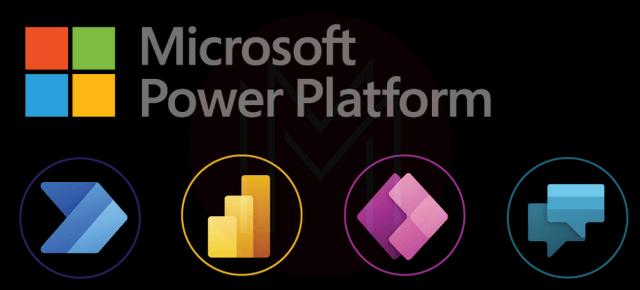
Given below are some of the facts and achievements of the Power Platform-
- Microsoft Power Platform was being used by around 16 million active users in 2021, up 97% year over year. This represents its high value and popularity across the world.
- The average salary of a Power Platform developer in the USA is $53.85 per hour or $105,000 per annum. The salary of highly experienced professionals might go up to $133,100 per annum. This is highly impressive and lucrative.
Having had background knowledge of Microsoft Power Platforms, let us move on to the questions. We will explore the interview questions and answers (updated-2024) separately for the following three categories-
Top 10 Power Platform Interview Questions
- Which data sources are supported by Power Apps?
- List the major components of BI.
- Tell us any 3 types of connectors available in Power Automate.
- What is a concurrent function in Power Apps?
- What are the different versions of Power BI?
- What do you mean by Power Query in Power BI?
- List some in-built AI models of Power Automate.
- Explain DAX from Power BI.
- Tell us about the licensing model of Microsoft Power Platform.
- List down some features of The Power Platform.
Power Platform Interview Questions for Freshers
1. List the major components of Power Apps.
Four major components of this highly productive business app are as follows-
- Model-driven apps
- Canvas apps
- Portals

(These are the types of apps that can be created using Power Apps.)
2. Which data sources are supported by Power Apps?
Following are some of the most common sources of Power Apps-
- SharePoint
- Microsoft Excel workbooks
- SQL server
- Other Office 365 apps
- Microsoft Dynamics
- Other CRM databases
3. When should a Model-driven app be used instead of a Canvas app?
When we can manage data with Dataverse defined tables, then Model-driven apps can be a simpler substitute for Canvas apps
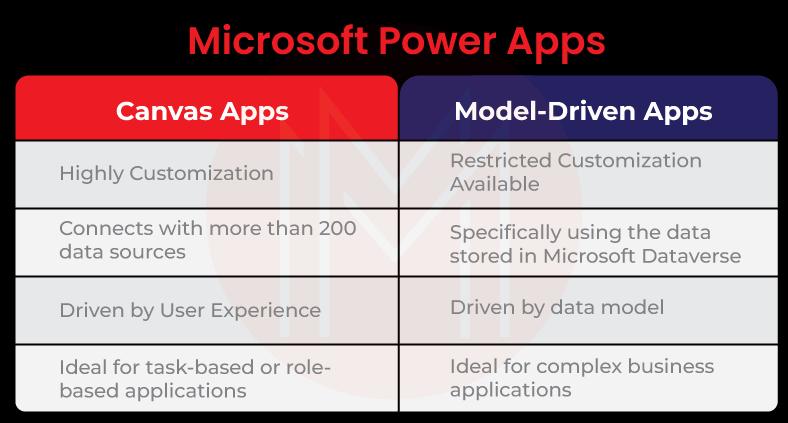
4. What options are available to use media files in the Canvas app?
200 MB of media can be uploaded for each app via Power Apps. But it is highly suggested to leverage media storage services such as Azure Storage and Azure media and put the media URL inside the app.
5. Explain the two parts of self-service Microsoft Business Intelligence.
The two parts of self-service BI are-
- Excel BI tool kit- It enables importing and modeling data from various as per our needs and hence creates interactive reports.
- Power BI- This online solution enables sharing the interactive queries and reports that have been created with the help of the Excel BI tool kit.
6. List the main comprehensive steps in the working system of Power BI.
The main steps are given below-
- Data importing
- Data cleaning
- Data visualization
- Save and publish
7. List the major components of BI.
- Power pivot
- Power query
- Power view
- Power map
- Power BI desktop
- Power BI mobile application
- Power Q&A
8. How can data be refreshed in BI?
By scheduling refresh in the Gateway of Power BI, the data can be refreshed.
| Want to enhance your skills in dealing with the world's best "Business Intelligence and Analytics Courses" , enroll in our: “Power Platform Training” Course. |
9. Tell us about the different types of flows available on Power Automate?
- Business process flows- Users can get scheduled work done by this flow. The work then gets broken down into steps for the best output.
- Cloud flows- By triggering the workflow in schedule, the flows get automatically executed.
- Desktop flows- It helps automate desktop tasks or web tasks.

10. Differentiate between the run desktop flow action and run sub-flow action in Power Automate.
Run desktop action- Another desktop flow called child desktop flow is initiated by this. Input variables can be initiated by this action.
Run sub-flow action- Here the sub-flow is initiated in the main desktop flow. Input variables can't be initiated by this action.
11. Tell us about the UI elements of the Power Automate.
It enables identifying and interacting directly with windows and the data via specific images which are recognized by the methods.
12. In which browsers can the Power Automate be used?
The Power Platform can be used in all the major browsers- Internet Explorer, Google Chrome, Mozilla Firefox, and Microsoft Edge.
13. Tell us any 3 types of connectors available in Power Automate.
- Blocked data group
- Business data group
- Non-business data group
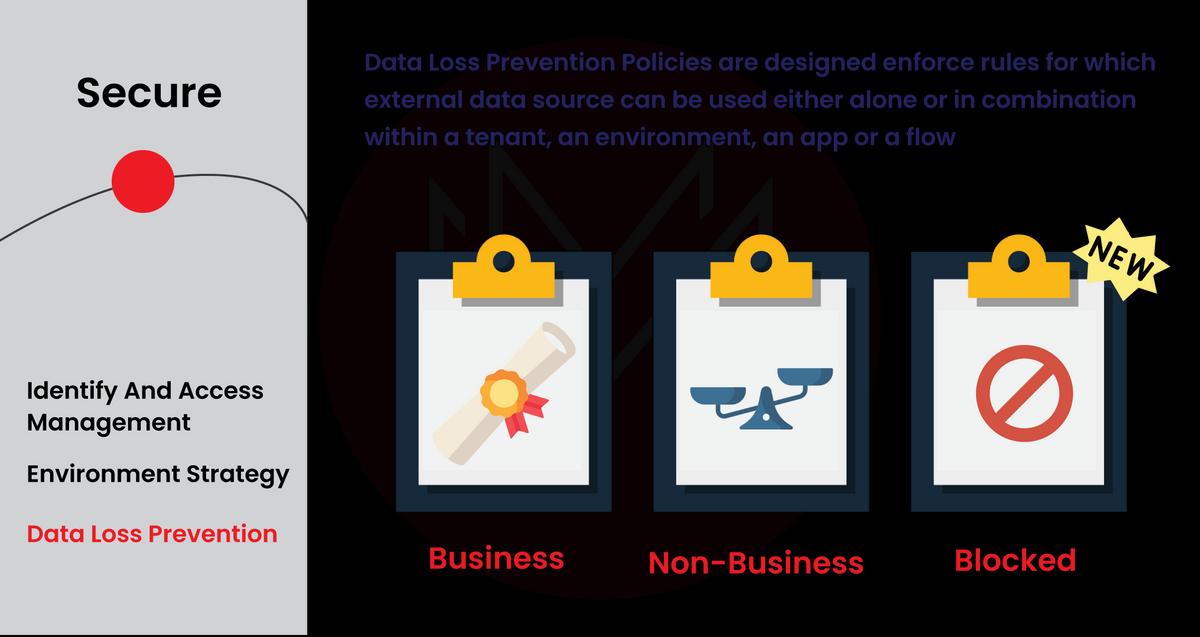
14. Which language is used in building automated flows for cloud/desktop?
A low-code general-purpose programming language- Microsoft Power Fx is used for the purpose.
15. List some benefits of Chat-bots.
- Improved customer service
- Keeping up with trends
- An easier approach to global markets
- Increased customer engagement
- Better qualification, lead generation, and nurturing
- Cost-saving
- Observing customer data and obtaining insights
Power Platform Interview Questions for Experienced
1. How can an attachment be stored in Power Apps?
- Choose the form where you want to add the attachment.
- Click on the "Databox" in the properties pane to open the data panel.
- From the list of fields, find the attachment field and turn it on.
- Publish your app after making its backup.
2. Explain the purpose of loading spinner in Power Apps.
When the loading is underway or if it is taking too much time, the loading spinner indicates it all. Loading spinner is available in the dropdown present at the top left of the app as well as in the advanced tab. It will appear every time a user opens the screen if set as an attribute to data.
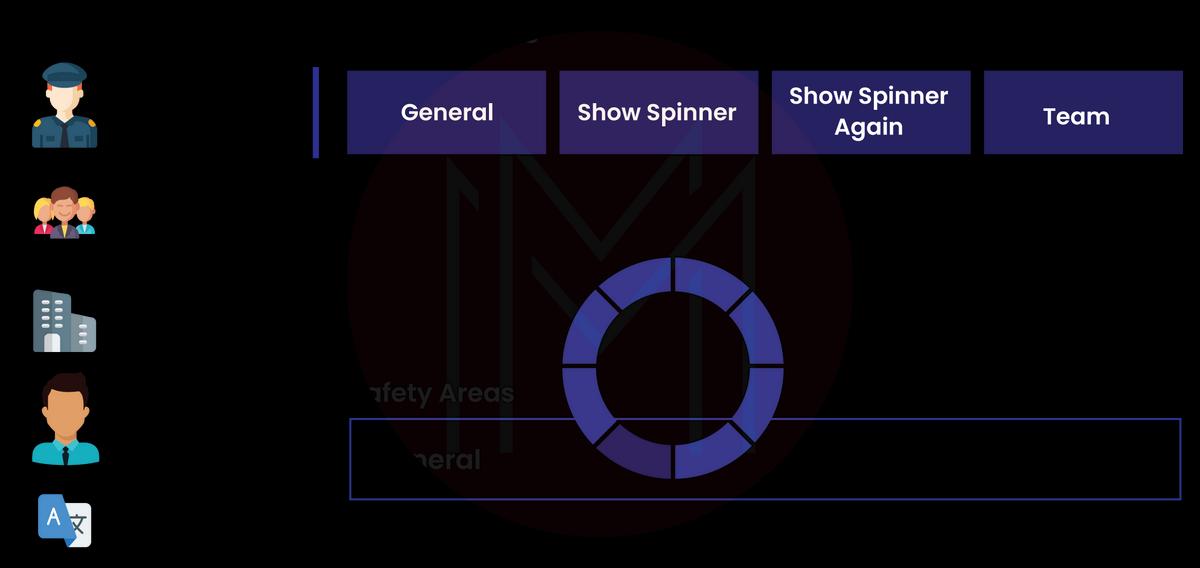
3. What is a concurrent function in Power Apps?
It can evaluate multiple formulas at the same time by chaining them together with the ";" operator. At least 2 formulas must be provided. Concurrent can be used to collect data from various tables instead of using formulas along with a semicolon. The syntax is like-
Concurrent(Formula1, Formula2 [, …])4. Explain the difference between the Match, IsMatch and MatchAll functions of the Power App.
IsMatch- True or False is returned as an answer depending on the matching of the string with the pattern, and it's done by a regular expression.
Match- It returns the first record matching the pattern.
MatchAll- A table is returned for each match discovered.
| Looking forward to a career in a Programming & Frameworks domain? Check out the "PowerApp Training" and get certified Today. |
5. What are the different versions of Power BI?
- Microsoft Power BI Free/Desktop- It is designed for anyone who wishes to view the business from the data along with the visualizations.
- Microsoft Power BI Pro- This Power BI version enables reporting, viewing, as well as sharing the reports which are not supported by the Power BI Desktop version.
- Microsoft Power BI Premium- This version doesn't provide a per-user license. Instead, a dedicated unit of capacity is provided for all the users in any organization.
6. Write about the different connectivity modes of Power BI.
Three different connectivity modes are there in Power BI which is given below-
- Import Mode- Since this one is the most used and also provides fast performance, it is the default mode. The data can be integrated from sources such as the web, CRM, social media, ERM, Excel, and dataflow. The imported data gets stored in the disk and while refreshing or querying, it is fully loaded.
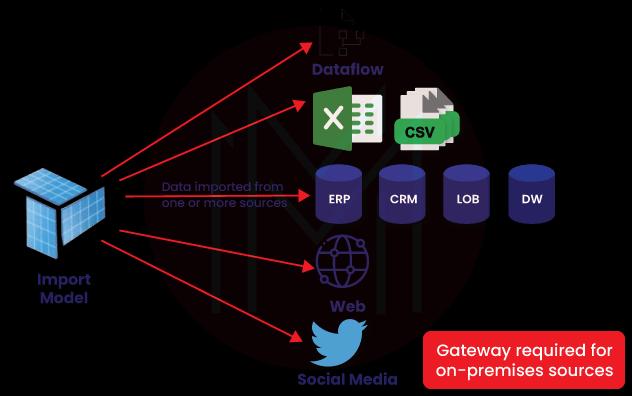
- Direct Query Mode- It is another method to import data by query to retrieve data from a data source existing already. Direct Query mode is used when the volume of data is huge to avoid refreshing which can take a long time.

- Composite Mode- It is an integration of both Import query and Direct query modes and hence the best of all. Calculated tables are also supported by this mode which is not supported by the Direct query mode.
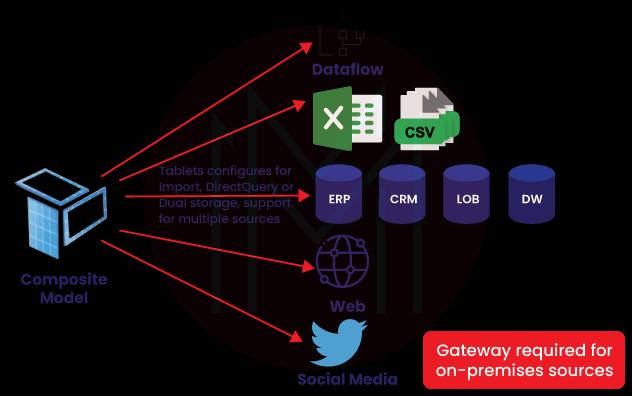
7. Mention the building blocks of Power BI along with examples of each block.
The building blocks of Power BI are-
- Dataset- It is the collection of data.
Example: Oracle, Excel sheets, or SQL server tables. - Visualization- It is a representation of data visually.
Example: Bar chart, Pie chart, Line graph, Treemap, etc. - Dashboard- It means one or more visualization integration into a single page layer.
Example: A sales dashboard can contain bar charts, pie charts, and geographical maps. - Report- It is the collection of visualizations.
Example: Profit by-products, Sales by Country, logistic performance, city performance, etc. - Tile- It is a single visualization on a dashboard or in a report.
Example: Bar chart in report or dashboard.
8. What do you mean by Power Query in Power BI?
Power query is an ETL tool that is used for cleaning, shaping, and transforming of the data with the help of various intuitive interfaces. It doesn't require coding. It enables users to-
- Import data from various sources like databases, social media, etc.
- Join and consolidate data from various data sources. Data can be shaped as per our requirements by removing and adding data.
| Check out: Top Power BI Interview Question and Answers |
9. Explain UI Flow Services in Power Automate.
It is a service based on windows installed in Power Automate for making the browser automated. It starts running the UI Flow Services automatically during installation. Power Automate is supported by this service for making it smooth in the cloud environment. We can do it via an on-premises data gateway.
10. Explain about AI builder in Power Automate.
AI is a feature found inbuilt in Power Automate which is used for designing optimized business processes. Your business is run by it in the Power Automate app. There is no need for choosing a model as all related models are inbuilt into the AI builder.
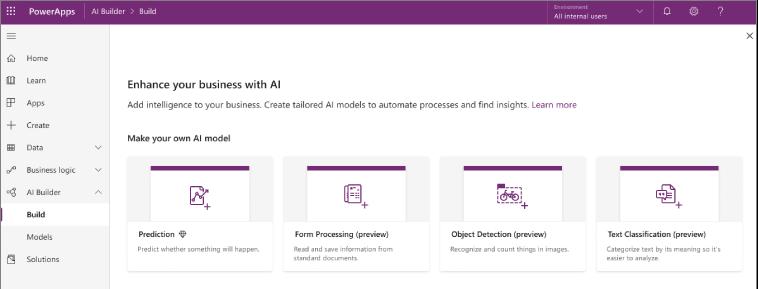
11. What does the process advisor do in Power Automate?
It is a tool that can guide you in understanding the business and the optimization can be done accordingly. Many scheduled tasks are also provided on mining by the power advisor.
12. List some in-built AI models of Power Automate.
- Entity extraction model
- ID card reader
- Language detection model
- Classification model
- Analytical reporting model
- Finance model
13. Mention some features of Power Virtual Agents.
Languages, Export and Import, Geos, Passing context, Multi-Author support, Power Automate Integration, Using global variables, and integration with Microsoft Power Platform are some of the features.
14. Mention the license choices for storage features available in Microsoft Power Platforms.
Storage capacity is provided via the following 3 types:
- Dataverse for Apps File capacity
- Dataverse for Apps Database capacity
- Dataverse for Apps Log capacity
15. Explain DAX from Power BI.
DAX means Data Analysis Expressions. It contains operators, functions, and constants, which are used in formulas for calculating and returning values. We can say it helps us in creating new information from the data we already have.
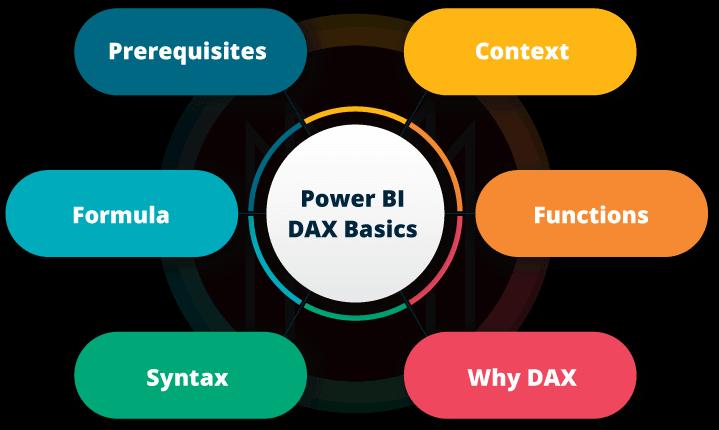
Frequently Asked Interview Questions on the Power Platform
1. What are the components of the Microsoft Power Platform?
The primary applications of Microsoft Power Platform are-
Power BI- It enables the users to fetch the required data from various sources into the Power Bi data model. And then, multiple functions can be performed to analyze the data.
Power Automate- It enables the users to reduce the manual work and automate all the organizational tasks without any code.
Power Apps- It can be used to develop mobile applications according to the needs for internal use in an organization.
Power Virtual Agents- It can be used to build robust chatbots to converse with external customers. It also allows integration with other Power platform tools such as Power Automate.
2. List some benefits of Microsoft Power Platform.
Following are some benefits of Power Platform-
- Sourcing of all the functions and services from a single platform. Therefore it is cost-saving also.
- It allows self-service, easing adoption and use.
- Provides the end-to-end linking capabilities among the products and hence streamlining the process.
- Remote work and collaboration are also provided.
- Security is maximized through embedded identity management, double encryption, and multi-factor authentication. Security facilities can be customized by the users as well.
3. Mention some major companies that use Power Platform tools.
Some of the major companies include Coca-Cola, Blackmores, H&M, IKEA Sweden, G&J Pepsi, Priceline stores, R3 Retail Development, EY, Pinnacle Group, IPS, Reliance Electric, and Ecolab companies that use Power Platform Tools.
4. Tell us about the licensing model of Microsoft Power Platform.
Business customers have certain versions of Microsoft 365 and Office 365 services and already have access to the Microsoft Power Platform. Just the employee training cost has to be covered. In case of non-availability, a license can be purchased for each of the products from the Power Platform. The license is provided in the following patterns-
Per-app plan- The users can use a single application or one portal.
Per-user plan- Enables a single user to run unlimited applications.
Pay as you go plan- Individual users can use a single application or 1 portal through Azure subscription and others. Payment has to be made for the number of users using the application in a month.
5. What security measures are available in the Power Platform tools?
It provides all the highest level of security standards and certifications that are offered by the Microsoft Azure platform to protect data.
6. Can Microsoft Power Platform be integrated with Office 365, Dynamics 365, and Microsoft Teams?
Yes, one of the strengths of the Microsoft Power Platform is its availability to integrate with other Microsoft solutions. For instance-
- Reports can be created in Microsoft 365 based on data from Microsoft Power BI and other applications.
- E-mail inquiries can be forwarded from Microsoft Power Automate to Microsoft Dynamics 365, in which a full range of CRM features is available.
- Applications designed with the help of Microsoft Power Apps and Azure Active Dictionary, a solution can be created and accessed from Microsoft Teams Messenger.
7. What are the benefits of using low-code Power Platform products?
The demand for digital tools is increasing while the ability of IT companies to deliver ready-to-use applications in a short period is decreasing. Also, companies are focusing on more cost-saving measures. These reasons make it beneficial to use the low code products.
8. Is Microsoft Power Platform PaaS or SaaS?
It is classified as PaaS, that is, Platform as a Service, because it provides a set of tools to build our custom applications to digitize business processes.
9. Where is data stored in Power Apps- Power Platform?
The data is stored securely in a data source called Dataverse in the form of a set of tables. The data can be brought into the app via a connection. A specific connector is used by the connection to talk to the data source. Therefore, if a cloud storage connector is chosen as the data source, then the data gets stored in the cloud.
10. List down some features of The Power Platform.
Given below are some major features of the Power Platform-
- Microsoft Dataverse- It enables the users to secure and manage data from multiple sources. Also, that data can be integrated using a common data model in different business applications.
- AI Builder- It refers to adding AI through a turnkey solution that enables the easy addition of intelligence to the apps and workflows. And then, the outcomes can be predicted without writing any code.
- Connectors- The data, apps, and devices can be connected in the cloud using these connectors. Microsoft Power Platform contains over 600 connectors. Examples include Twitter, Office 365, Google services, Dropbox, Salesforce, and many more.
Conclusion
These were some of the Power Platform Interview Questions that could be asked in your next interview. Microsoft Power Platform is a multi-purpose service that is being used in various major companies across the world. This opens the door of the room with vast opportunities lying ahead. You have come this far, and now just a little practice is all that you need to cross that door. So all the very best for your last step.
 On-Job Support Service
On-Job Support Service
Online Work Support for your on-job roles.

Our work-support plans provide precise options as per your project tasks. Whether you are a newbie or an experienced professional seeking assistance in completing project tasks, we are here with the following plans to meet your custom needs:
- Pay Per Hour
- Pay Per Week
- Monthly
| Name | Dates | |
|---|---|---|
| Power Platform Training | Dec 27 to Jan 11 | View Details |
| Power Platform Training | Dec 30 to Jan 14 | View Details |
| Power Platform Training | Jan 03 to Jan 18 | View Details |
| Power Platform Training | Jan 06 to Jan 21 | View Details |

















